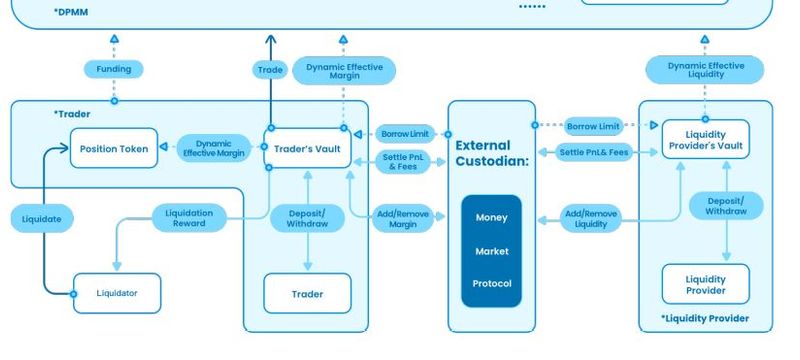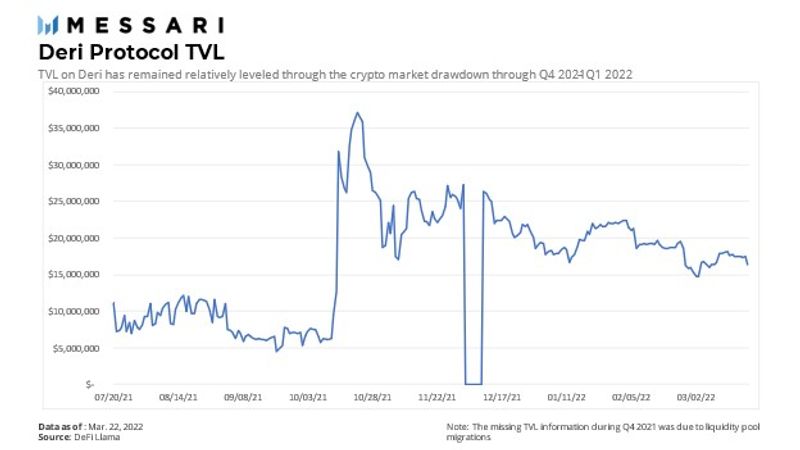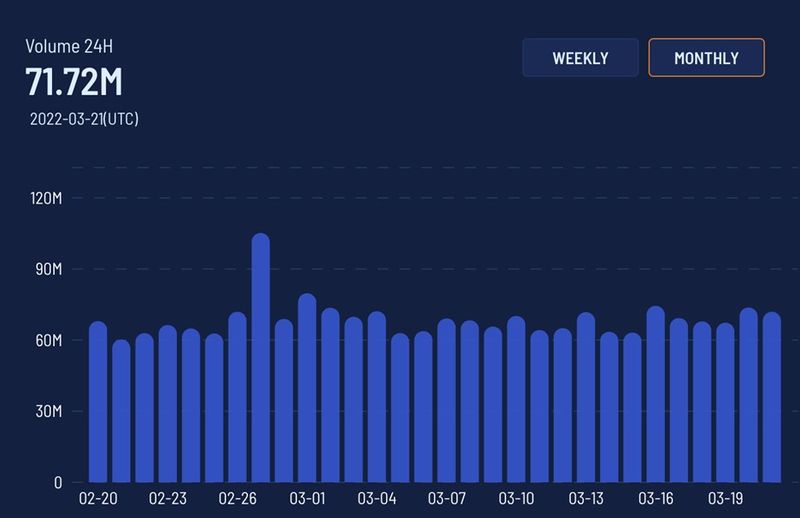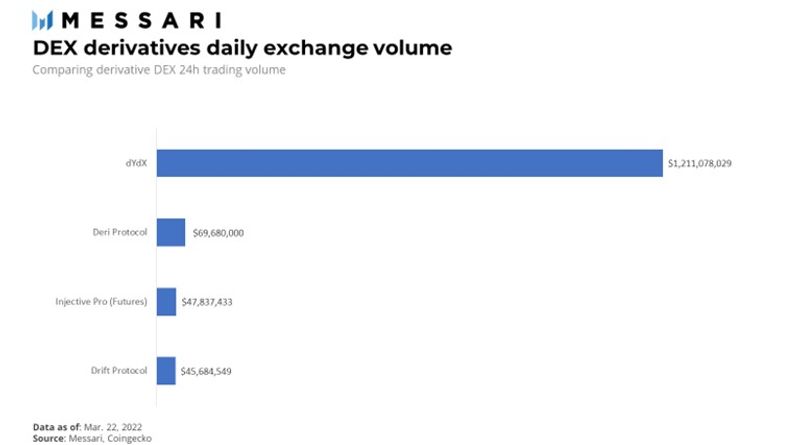Key Insights:
- Innovations within the decentralized exchange ecosystem continue to progress despite the current crypto market downtrend.
- Deri’s recent network architecture upgrade of the Deri Proactive Market Making aims to increase capital efficiency and innovative derivatives products.
- Upgrades to Deri’s Everlasting Options contract and the introduction of Power Perpetuals aim to bring asymmetric risk/reward strategies for traders and unique hedging strategies for liquidity providers.
- The Deri roadmap for 2022 offers continual updates and improvements to the platform with upcoming multichain liquidity features and additional governance use cases for DERI holders.
Derivatives have been a powerful financial tool for decades. They can do anything from providing exposure to asymmetric bets to implementing unique risk management strategies. As crypto amasses more institutional interest, derivatives products have taken a front and center position amongst the technological innovations within the space.
Crypto exchanges have been at the forefront of derivatives products innovation. They started with BitMEX introducing funding-fee-based perpetual swaps and developed into today’s decentralized exchanges (DEXs) reshaping trader and investor participation. As exchanges continue to evolve, DEXs can become the cornerstone of these advancements by leveraging the innovative mechanisms introduced by decentralized finance (DeFi) protocols.
About Deri Protocol
Introduction to the DPMM
DPMM and Tokenized Positions
Deri Protocol is a derivatives DEX first introduced by Dfactory Ltd. in February 2021 that has been pushing the technological innovation of derivatives in the DeFi ecosystem. The platform architecture is based on the proactive market-making (PMM) mechanism, first introduced by DODO. The PMM uses a virtual order book to offer an increased capital efficiency compared to a traditional automated market maker (AMM) mechanism such as Uniswap’s. The PMM mimics the functions of a traditional order-book-based centralized exchange (CEX) by allowing liquidity providers (LPs) to execute trades against the virtual order book. Therefore, the PMM ultimately aims to reduce the amount of impermanent loss and price slippage witnessed in traditional AMMs.
Deri’s main goal is to continue improving its platform’s capital efficiency. As such, Deri introduced the Deri proactive market-making (DPMM) mechanism, an altered version of a traditional PMM. The DPMM architecture was first integrated in Q4 2021 and since then has received network architecture updates which are outlined in this report and are the basis for the Deri V3 upgrades.
Significance of NFTs in the DPMM
The DPMM architecture relies heavily on the tokenization of traders’ positions in the form of composable NFTs. In order for information pertaining to each position to be easily stored and transferred between Deri and third-party DeFi protocols, trader positions are tokenized in the form of NFTs. Users can also trade and provide liquidity with multiple types of base tokens as collateral and/or settlement across the various products on the Deri platform.
Introduction to Deri V3 Upgrades
As previously mentioned, Deri’s main focus is to increase capital efficiency for its users. The project team has made significant upgrades to its network architecture and provided new products on its platform with the Deri V3 upgrade. Upgrades to the DPMM architecture include:
- Uniform DPMM: The DPMM network architecture has been updated to allow for any funding-fee-based derivatives to be handled by a single liquidity pool.
- The Vault and external custody: The Vault or Money Market Protocol is an external custodian in the form of a smart contract in order to retain the real-time balance of a user’s capital consisting of multiple base tokens.
- Greek-based Everlasting Options: Deri has upgraded its Everlasting Options product from a margin-based algorithm to a Greek-based margin system. This change mitigates the small chance a user’s position is liquidated due to discrepancies between margin requirements and profit increments when price changes favorably to a position.
- Power Perpetuals derivatives: Deri has also added a new product to its platform named Power Perpetuals. It allows users to trade the exponent of the price of an asset and hedge against impermanent loss.
Deri V3 Upgrade: Impact and Purpose
DPMM Architecture Change
Uniform DPMM trading pools
Mainly, Deri has simplified the DPMM network architecture by providing a single liquidity pool for its perpetual futures and Everlasting Options products. Before, the DPMM relied on separate smart contracts/liquidity pools to settle trades for individual derivatives types. However, in order for the platform to scale and support additional base tokens, the DPMM has been upgraded to allow for any funding-fee-based derivatives to be handled by a single liquidity pool.
In the past, the DPMM relied on separate smart contracts/liquidity pools to settle trades for individual derivatives types. This approach can be too complicated for the platform to scale and support additional base tokens. As a result, Deri simplified the DPMM network architecture by providing a single liquidity pool for its perpetual futures and everlasting options products. This upgrade allows for any funding-fee-based derivatives to be handled by one liquidity pool.
The removal of separate liquidity pools based on derivatives types allows for users to trade multiple derivatives of the same underlying asset simultaneously. With this simplification, traders can view all the risk variables associated with their position, such as the Greeks (Gamma, Delta, etc.), and manage speculation and risk strategies much more simply.
However, the implications of the DPMM upgrade go far beyond bolstering capital efficiency for traders. The simplification also allows for additional experimentation with new derivatives types on the DPMM. By leveraging composability, new derivatives can be plugged into existing DPMM trading pools where users can immediately interact with them. In this way, Deri has developed a platform where innovative derivatives products can be live-tested with other derivatives on the upgraded DPMM. Users can use these features to further innovate on ways to use derivatives products in their portfolio management strategies.

Source: Deri Whitepaper
The Vault
Deri also introduced the Vault, a smart contract within the DPMM that interacts with external custodians. In order for Deri to properly secure user funds in a decentralized manner, the team chose to introduce external custody for user capital deposited on Deri.
In order to achieve this, the team decided to use established money market protocols as external custodians such as Compound and/or AAVE (for ERC-20 assets) and Venus (for BEP-20 assets). This way, Deri minimizes the risk of potential internal custody issues (centralization and security risks) and leverages trustworthy protocols to secure user funds while maintaining Deri’s decentralized characteristics.
How the Vault Works
When a user first deposits capital on Deri, either to provide margin or liquidity, a unique Vault is deployed for that user. Since Deri supports a multi-base-token network, the total dynamic effective value of each user’s capital must be known in order to process and calculate user transactions and trades appropriately. Therefore, the Vault sends the capital to the money market protocol where the total dynamic effective value of the capital can be calculated. This calculation is possible due to the money market protocol’s ability to support multiple tokens on its platform and produce the calculation for each user.
With the integration of the Vault protocol, Deri can accurately pull the data of each user’s multi-base-token balance and retain real-time effective value, which further facilitates capital efficiency on the platform.

Source: Deri Whitepaper
Greek-based Margin System for Everlasting Options:
Up until now, Deri utilized a margin-based algorithm for its Everlasting Options products. In order to cover the loss of a position when the underlying price has changed unfavorably, the proper margin requirement is applied by the algorithm to cover the loss. However, the Deri team recognized that this traditional method isn’t efficient when it comes to non-linear derivatives such as options.
The risk Deri identified is related to a scenario where the underlying asset price moves favorably to a position. In this situation, if the margin required to maintain the options position is increased, the increase cannot be greater than the increase in profit. If this were to occur, the margin requirement would surpass the profit increase, triggering the liquidation of the position.
In order to avoid this scenario, Deri integrated a Greek-based margin system for Everlasting Options.
“The Greeks” refers to the risk characteristics of a derivatives contract. Deri utilizes two of these, mainly Delta and Gamma:
- Delta (first-order derivative): the rate of change between the price of a derivative and a $1 change in the price of the underlying asset.
- Gamma (second-order derivative): the rate of change between the Delta of a derivative and the price of the underlying asset.
The Greeks allow the protocol to estimate the rate of change of the options position value due to the price change of the underlying asset. With this information, margin can be appropriately increased to the options position without surpassing the increase of the underlying price and avoiding the position’s liquidation.
Power Perpetuals
One of Deri’s new products introduced in the V3 upgrade is the Power Perpetual. The concept was first introduced by Paradigm in August 2021 and introduces new methods for traders to manage risk and speculate on crypto assets. Power Perpetuals essentially represent the exponent of an underlying asset. For example, the Power Perpetuals of BTC are represented as BTC^2, BTC^3, etc. This new type of derivative offers options-like exposure without the time constraints associated with expiration and strike prices.
Deri’s integrated Power Perpetuals contracts provide an asymmetric advantage to longs by boosting their upside profit and mitigating downside loss. This occurs because the change in price for the Power Perpetual is far greater than the associated increase in the price of the underlying asset. If BTC doubles, BTC^2 increases 4x, BTC^3 increases 8x, and so forth. However, if the price were to drop, the relative loss to Power Perpetual longs is far less than the potential upside. This dynamic is called “positive convexity” and provides asymmetric advantages to Power Perpetual holders.
The inverse is true for users that choose to short Power Perpetuals: the losses in comparison to the gains if price increases are not favorable. However, to balance the disadvantage for short positions, traders that are long Power Perpetuals must always pay a funding fee to shorts. For Power Perpetuals, longs are the only positions that payout funding to short positions. It should be noted that users only have to pay funding once they’ve opened a long position.
Hedging Impermanent Loss with Power Perpetuals
Another use case Deri has adopted for Power Perpetuals is hedging against impermanent loss. Impermanent loss refers to the relative losses accepted by LPs due to price fluctuations of the tokens they’ve provided. However, losses are realized only when LPs withdraw tokens from dual-asset liquidity pools.
LP tokens also have a Delta and Gamma risk exposure to their underlying assets; however, Gamma, the second-order derivative, complicates the ways in which traders can hedge. This is where Power Perpetuals come into play. Due to Power Perpetual’s positive convexity feature, the Gamma associated with the contract is positive. Therefore, the exposure to Gamma risk is minimized, introducing a Gamma neutral position.
This position could not be achieved with a traditional, linear derivative such as a futures contract, because the futures position would need to be continually rebalanced in order to mitigate Gamma risk for LPs.
Furthermore, LPs must also hedge against Delta risk exposure. Therefore, a short position on a linear futures contract of the underlying asset is required to ensure Delta risk neutrality. Deri has provided an example of how this can work in their most recent announcement:

Source: Deri Medium
Deri’s Power Perpetual platform officially launched on March 14, 2022, and hosts up to 18 unique base tokens mentioned in the most recent Deri Telegram AMA.
Traction
Although Deri was affected by the general crypto market drawdown, its total value locked (TVL) has remained stable since Q4 2021.

The platform has also managed to maintain an average of $70 million of daily trading volume through Q1 2022. When compared to the top derivatives DEXs, Deri has also made significant progress in maintaining user participation.


Roadmap
After the successful rollout of the Deri V3 upgrade and Power Perpetuals integration, Deri continues to innovate and provide nuanced financial instruments.

The team continues to add new base tokens for its perpetual futures and Everlasting Options products. Across Ethereum, BNB Smart Chain, and Polygon, the project now offers around 26 unique base tokens for users to trade and stake on Deri’s platform. The project also plans to integrate additional governance privileges for DERI holders. Users will be able to vote on and propose asset management strategies and ecosystem fund allocation for DeFi-based projects/products integrated with Deri.
Finally, the team has announced it will provide a Deri V4 upgrade in Q4 2022. Providing multichain liquidity will be the main feature integration to the existing DPMM for this upgrade.
Conclusion
Despite the uncertainty in crypto markets this year, Deri keeps humming along. It has not only maintained its user activity, but it has also continued to integrate innovative products with the DPMM. DEXs have played a key role in structuring the way DeFi has evolved up until now and can be considered the gateway products for the majority of crypto retail investors. Deri hasn’t missed a beat since the publishing of the introductory report and is showing no signs of stopping from becoming a significant competitor in the derivatives DEX sector.
This report was commissioned by Deri Protocol, a member of Protocol Services. All content was produced independently by the author(s) and does not necessarily reflect the opinions of Messari, Inc. or the organization that requested the report. Paid membership in Protocol Services does not influence editorial decision or content. Author(s) may hold cryptocurrencies named in this report.
Crypto projects can commission independent research through Protocol Services. For more details or to join the program, contact ps@messari.io.
This report is meant for informational purposes only. It is not meant to serve as investment advice. You should conduct your own research, and consult an independent financial, tax, or legal advisor before making any investment decisions. Past performance of any asset is not indicative of future results. Please see our terms of use for more information.















